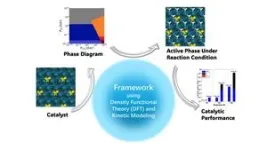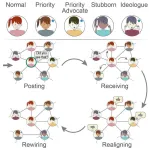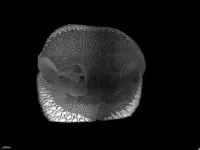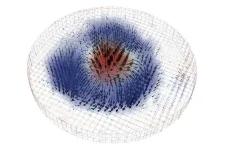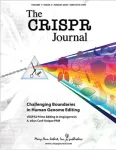(Press-News.org) UPTON, N.Y. — Chemists at the U.S. Department of Energy’s (DOE) Brookhaven National Laboratory have developed a new theoretical framework for more accurately predicting the behavior of catalysts. These collections of atoms lower the energy needed for countless chemical reactions. The study reveals how conditions such as temperature and pressure can change a catalyst’s structure, efficiency, and even the products it makes. The findings are published in the journal Chem Catalysis.
“Our results highlight the significant impact the reaction environment can have on catalytic performance,” said Ping Liu, a theorist in Brookhaven Lab’s Chemistry Division who is also an adjunct professor at Stony Brook University (SBU) and oversaw the research. “We show that these catalyst-environment interactions can be used to tune the efficiency and selectivity of catalysts, which could point to new ways to design better catalysts.”
For the study, the scientists modeled catalysts that help hydrogen (H2) convert carbon dioxide (CO2), a greenhouse gas, into a range of other products, including methanol. The catalysts were made of palladium (Pd) partnered with other metals — zinc (Zn) or silver (Ag) — that scientists had previously shown to be effective for the “CO2 hydrogenation” reaction.
They were motivated by a big discrepancy in earlier research on this reaction. In previously published experiments, metallic palladium preferentially produced formic acid (HCOOH). But theoretical calculations predicted that methanol (H3COH) should be the most energetically favorable product.
“This contradiction between theory and experiment made us wonder why there are differences. What are we missing?” Liu asked.
Hong Zhang, Liu’s graduate student at SBU and the first author on the paper, designed a way to find out by modeling what happens during the reaction.
“We developed a framework based on density function theory and kinetic modeling to capture the dynamic behavior and structure of the catalyst under operational reaction conditions,” Zhang said.
The density function theory calculations determine the most likely arrangements and interactions of atoms. The kinetic modeling shows how reactants are transformed from one step of the reaction to the next through a series of intermediates. The idea behind this approach is to bridge the gap between studies of catalysts in their purest, just-made condition and studies that look at catalysts after a reaction is complete.
“The reality is that a catalyst often undergoes significant structural changes or phase transitions in the reaction environment,” Liu said. “But those reaction-driven dynamics are difficult to capture experimentally at the atomic level, even using the amazing characterization tools we have for studying catalysts in real time.”
She noted that the new modeling framework, together with the experimental characterization tools, will provide the precise understanding of catalytic mechanisms that’s needed to guide future catalyst designs.
The modeling framework
Zhang explained how the framework works.
“We start with modeling the as-prepared catalyst — in this case, zinc deposited onto the palladium surface,” he said. “Experimentally, after preparing the catalyst, scientists expose the sample to the mixture of hydrogen and carbon dioxide. We do the same thing using modeling,” Zhang said.
“We consider many representative ‘species’ — reactants and intermediates — that could be present or could form in the particular reaction conditions and have the potential to be stable, as well as how the surface of the catalyst might change.”
Then, the scientists mapped out those “phase changes” in the catalyst under different pressures of carbon dioxide and hydrogen at different temperatures. They discovered which conditions pushed the reaction forward and changed the pathway to produce different products.
At room temperature, they found that the catalytic surface was essentially covered with hydrogen, which blocked the reaction from starting. Raising the temperature produced hydrogen vacancies and gave carbon dioxide access to the active palladium sites. That access initiated the conversion of carbon dioxide and hydrogen to formic acid.
“Going to higher temperatures, we saw even more of a decrease in hydrogen coverage,” Liu said.
More hydrogen vacancies further increased the conversion of carbon dioxide.
“This was expected since most reactions proceed faster at higher temperatures,” Liu explained. “But we also saw a change in selectivity. The reaction went from producing formic acid to producing more and more carbon monoxide and methanol,” she said.
The change in selectivity was somewhat unexpected, but it explained the prior discrepancy between theory and experiment.
“We found that changing the temperature actually changes the active sites of the catalyst, from single hydrogen vacancies to dimers or trimers — pairs or triplets — of missing hydrogens,” Liu said. “Those larger hydrogen vacancies change the catalyst’s selectivity to favor methanol production,” she said.
The scientists then validated and verified that the framework will work for modeling other catalysts. They tested it on pure palladium, a bulk alloy of palladium and zinc where the zinc is not just on the subsurface layer, and a bulk alloy of palladium and silver.
“We simply calculated the surface diagram of these catalysts under the experimental conditions that others have studied. Depending on the coverage of the surface in these conditions, we can easily predict the selectivity,” Liu said. “In all three cases, the framework we developed can accurately describe the experimentally observed selectivity with significantly reduced computing cost.”
This work, she said, has strengthened the interaction of the theoretical and experimental approaches to understanding catalyst structures and mechanisms, as well as how reaction conditions can be used to tune catalytic activity.
“This whole framework goes way beyond the CO2 hydrogenation reaction and the palladium-based catalysts,” Liu said. “It provides a way to gain a deeper understanding of catalysts’ active sites and how they work under operating conditions. This will help establish a structure-catalysis relationship with enhanced precision, which is essential for the design of active and selective catalysts.”
This work was funded by the DOE Office of Science. The calculations used computational resources at the Center for Functional Nanomaterials (CFN), a DOE Office of Science user facility at Brookhaven Lab, and the high-performance SeaWulf computing system of Stony Brook University, made possible by a grant from the National Science Foundation.
Brookhaven National Laboratory is supported by the Office of Science of the U.S. Department of Energy. The Office of Science is the single largest supporter of basic research in the physical sciences in the United States and is working to address some of the most pressing challenges of our time. For more information, visit science.energy.gov.
Follow @BrookhavenLab on social media. Find us on Instagram, LinkedIn, X, and Facebook.
END
Reaction conditions tune catalytic selectivity
Study reveals potential for leveraging catalyst-environment interactions to design more efficient, effective catalysts
2024-10-22
ELSE PRESS RELEASES FROM THIS DATE:
Verified users on social media networks drive polarization and the formation of echo chambers
2024-10-22
When X (formerly Twitter) changed its verification system in 2022, many foresaw its potential to impact the spread of political opinions on the platform. In a modeling study publishing October 22 in the Cell Press journal iScience, researchers show that having verified users whose posts are prioritized by the platform’s algorithms can result in increased polarization and trigger the formation of echo chambers. Because X’s new verification system allows almost anybody to become verified, this side effect could be taken advantage of by users wishing to manipulate others’ opinions, the researchers say.
“Our findings confirm ...
Get a grip: The best thumb position for disc launch speed and spin rate
2024-10-22
WASHINGTON, Oct. 22, 2024 – Disc golf is a sport growing in popularity, but there hasn’t been much research into the best techniques – until now.
Researcher Zachary Lindsey and his team studied professional and amateur disc golf players in Georgia to analyze the effect of thumb grip on disc-throwing.
“Participants were eager and excited to engage in the study, as there is clearly a thirst for scientific evidence and data to drive progress in the sport so that disc golf enthusiasts can improve their game in recreational and competitive contexts,” ...
Maternal eating disorders, BMI, and offspring psychiatric diagnoses
2024-10-22
About The Study: In this population-based cohort study including 392,000 mothers and 649,000 offspring, offspring from mothers with an eating disorder history or pre-pregnancy body mass index (BMI) outside normal weight were at higher risk of psychiatric disorders. The results differed somewhat between the 2 exposures with regard to which offspring diagnoses had associations, and effect sizes were typically larger for maternal eating disorders vs BMI. These findings suggest a need to consider these 2 exposures clinically to help prevent offspring mental illness.
Corresponding Author: To contact the corresponding author, Ida A. K. Nilsson, PhD, email ida.nilsson@ki.se.
To ...
Geometric mechanics shape the dog's nose
2024-10-22
The noses of many mammals, such as dogs, ferrets and cows, feature grooves forming a multitude of polygons. A team from the University of Geneva (UNIGE) has analyzed in detail how these patterns form in the embryo using 3D imaging techniques and computer simulations. The researchers discovered that differential growth of the skin tissue layers leads to the formation of domes, which are mechanically supported by the underlying blood vessels. This work describes for the first time this morphogenetic process, which could help explain the formation of other biological structures ...
‘Visual clutter’ alters information flow in the brain
2024-10-22
New Haven, Conn. — Whether we’re staring at our phones, the page of a book, or the person across the table, the objects of our focus never stand in isolation; there are always other objects or people in our field of vision. How that visual “clutter” affects visual processing in the brain, however, is not well understood.
In a new study published Oct. 22 in the journal Neuron, Yale researchers show that this clutter alters how information flows in the brain, as does the precise location of that clutter within the wider field of vision. The findings ...
Researchers succeed in taking 3D x-ray images of a skyrmion
2024-10-22
A difficult-to-describe nanoscale object called the magnetic skyrmion might one day yield new microelectronic devices that can do much more — for example, massive data storage — all while consuming much less power.
But researchers need a more detailed understanding of skyrmions if they are ever to be used reliably in computational devices, including quantum computers. Peter Fischer, a senior researcher at the Department of Energy’s Lawrence Berkeley National Laboratory (Berkeley ...
MRI can save rectal cancer patients from surgery, study suggests
2024-10-22
Magnetic resonance imaging (MRI) can spare many patients with rectal cancer from invasive surgery that can carry lifelong side effects, new research indicates.
The findings, from UVA Cancer Center’s Arun Krishnaraj, MD, MPH, and collaborators, indicate that MRI can predict patient outcomes and the risk of the tumor reccurring or spreading for patients who have undergone chemotherapy and radiation.
That information could be extremely useful in determining the best course of treatment and deciding whether a patient can ...
Fyodor Urnov on clinical crisis in CRISPR genome editing
2024-10-22
New Rochelle, NY, October 18, 2024—An invited Guest Editorial entitled “Give Cas a Chance,” by Fyodor Urnov, PhD, Director of Technology & Translation at the Innovative Genomics Institute (IGI), anchors the October 2024 special issue of The CRISPR Journal on “CRISPR Trials.”
As guest editor of the special issue, Dr. Urnov has penned an extraordinary editorial that emphatically defines the magnitude of the crisis in the genome editing arena and offers a path forward. The inherently programmable nature of CRISPR gene editing that makes it ...
People with type 2 diabetes who eat low-carb may be able to discontinue medication
2024-10-22
WASHINGTON—Adults with type 2 diabetes on a low-carbohydrate diet may see benefits to their beta-cell function allowing them to better manage their disease and possibly discontinue medication, according to new research published in the Endocrine Society’s Journal of Clinical Endocrinology & Metabolism.
Beta-cells are endocrine cells in the pancreas that produce and release insulin, the hormone that controls blood sugar levels.
More than 38 million Americans have diabetes, and over 90% of them have ...
Air pollution linked to having a peanut allergy during childhood
2024-10-22
Exposure to higher levels of air pollution as a baby is linked to having a peanut allergy throughout childhood, according to a new study. And policies aimed at tackling poor air quality could potentially reduce the prevalence and persistence of peanut allergies, it stated.
The research, led by Murdoch Children’s Research Institute (MCRI) and the University of Melbourne, found being exposed to higher levels of air pollution from infancy was associated with increased odds of developing a peanut allergy and having the allergy persist across the first 10 years of life. However, the same association was not seen for egg allergy or eczema.
Published ...
LAST 30 PRESS RELEASES:
Sleeping in on weekends may help boost teens’ mental health
Study: Teens use cellphones for an hour a day at school
After more than two years of war, Palestinian children are hungry, denied education and “like the living dead”
The untold story of life with Prader-Willi syndrome - according to the siblings who live it
How the parasite that ‘gave up sex’ found more hosts – and why its victory won’t last
When is it time to jump? The boiling frog problem of AI use in physics education
Twitter data reveals partisan divide in understanding why pollen season's getting worse
AI is quick but risky for updating old software
Revolutionizing biosecurity: new multi-omics framework to transform invasive species management
From ancient herb to modern medicine: new review unveils the multi-targeted healing potential of Borago officinalis
Building a global scientific community: Biological Diversity Journal announces dual recruitment of Editorial Board and Youth Editorial Board members
Microbes that break down antibiotics help protect ecosystems under drug pollution
Smart biochar that remembers pollutants offers a new way to clean water and recycle biomass
Rice genes matter more than domestication in shaping plant microbiomes
Ticking time bomb: Some farmers report as many as 70 tick encounters over a 6-month period
Turning garden and crop waste into plastics
Scientists discover ‘platypus galaxies’ in the early universe
Seeing thyroid cancer in a new light: when AI meets label-free imaging in the operating room
Neutrophil-to-lymphocyte ratio may aid risk stratification in depressive disorder
2026 Seismological Society of America Annual Meeting
AI-powered ECG analysis offers promising path for early detection of chronic obstructive pulmonary disease, says Mount Sinai researchers
GIMM uncovers flaws in lab-grown heart cells and paves the way for improved treatments
Cracking the evolutionary code of sleep
Medications could help the aging brain cope with surgery, memory impairment
Back pain linked to worse sleep years later in men over 65, according to study
CDC urges ‘shared decision-making’ on some childhood vaccines; many unclear about what that means
New research finds that an ‘equal treatment’ approach to economic opportunity advertising can backfire
Researchers create shape-shifting, self-navigating microparticles
Science army mobilizes to map US soil microbiome
Researchers develop new tools to turn grain crops into biosensors
[Press-News.org] Reaction conditions tune catalytic selectivityStudy reveals potential for leveraging catalyst-environment interactions to design more efficient, effective catalysts

